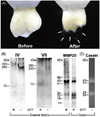Enamel organic matrix: potential structural role in enamel and relationship to residual basement membrane constituents at the dentin enamel junction
- PMID: 25158177
- PMCID: PMC4537066
- DOI: 10.3109/03008207.2014.923883
Enamel organic matrix: potential structural role in enamel and relationship to residual basement membrane constituents at the dentin enamel junction
Abstract
Although mature enamel is predominantly composed of mineral, a previously uncharacterized organic matrix layer remains in the post-eruptive tissue that begins at the dentin enamel junction and extends 200-300 μm towards the outer tooth surface. Identification of the composition of this layer has been hampered by its insolubility; however, we have developed a single step method to isolate the organic enamel matrix relatively intact. After dissociative dissolution of the matrix with SDS and urea, initial characterization by Western blotting and gel zymography indicates the presence of type IV and type VII basement membrane collagens and active matrix metalloproteinase-20. When combined with data from transgenic knockout mice and from human mutations, these data suggest that the enamel organic matrix (EOM) and dentin enamel junction may have a structural and functional relationship with basement membranes, e.g. skin. To clarify this relationship, we hypothesize a "foundation" model which proposes that components of the EOM form a support structure that stabilizes the crystalline enamel layer, and bonds it to the underlying dentin along the dentin enamel junction. Since we have also co-localized an active matrix metalloproteinase to this layer, our hypothesis suggests that, under pathologic conditions, MMP-mediated degradation of the EOM could destabilize the enamel-dentin interface.
Keywords: Basement membrane; MMP-20; dentin enamel junction; mature human enamel; type IV collagen; type VII collagen.
Figures



References
-
- Paine M, White S, Luo W, Fong H, Sarikaya M, Snead M. Regulated gene expression dictates enamel structure and tooth function. Matrix Biol. 2001;20:273–292. - PubMed
-
- White SN, Luo W, Paine MP, Sarikaya M, Snead ML. Biological organization of hydroxyapatite crystallites into a fibrous continuum toughens and controls anisotropy in human enamel. J Dent Res. 2001;80:321–326. - PubMed
-
- White SN, Paine MP, Luo W, Sarikaya M, Fong H, Yu Z, Li ZC, Snead ML. The dentino-enamel junction is a broad transitional zone uniting dissimilar bioceramic composites. J Am Ceram Soc. 2000;83:238–240.
-
- Eastoe J. Organic matrix of tooth enamel. Nature. 1960;197:411–412. - PubMed
Publication types
MeSH terms
Substances
Grants and funding
LinkOut - more resources
Full Text Sources
Other Literature Sources
